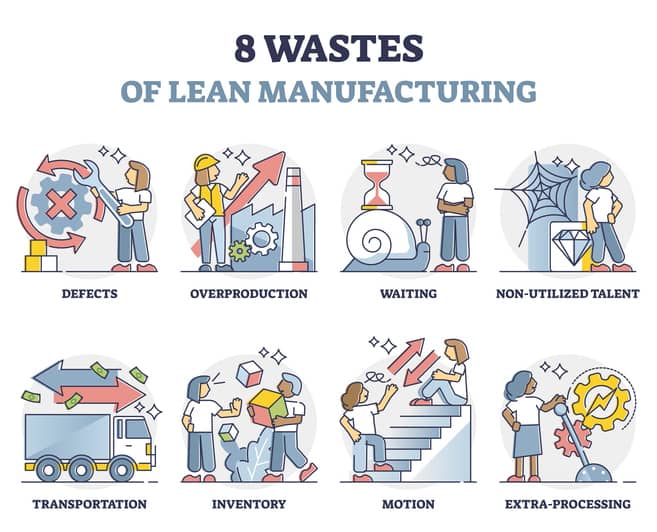Those who have read about Lean know the whole point is to cut waste or non-value adding operations and actions within a process. This can involve everything from workers having to take too many steps on the manufacturing floor to office workers duplicating paperwork.
Eliminating waste works. But it requires careful examination of the process to identify exactly how a current process works. There are Lean tools to accomplish this, but the question for some is:
When it comes to value-added vs. non-value-added operations, how can I tell the difference?
This question is often hard to answer. Many processes are complicated, involving many people. Just creating a process map or value stream mapping the current operation can seem an interminable task.
However, Lean provides ways to identify areas of non-value-added and value-added actions.
The Eight Wastes
The first thing to remember with the following – in fact, with anything involving Lean – is that every action in a process is evaluated in the context of whether it leads to improved value for the customer. If not, then it needs to go.
The following eight wastes rank as the biggest areas of non-value-adding activity. These are easy to remember – just think of the acronym DOWNTIME.
- Defects – Products or services that are not acceptable to customers
- Overproduction – Making products faster, sooner or in greater number than needed
- Waiting – Employees waiting for products to be worked on or for information to be processed
- Non-utilized talent – Not using everyone’s talent to solve challenges – or even worse, not consulting them at all
- Transportation – Transportation as a waste means that products are moved from Point A to Point B without adding any value
- Inventory – This term covers materials, information, work in process and finished goods that are not stocked and supplied in the most efficient way possible
- Motion – Wasted motion, or requiring too much motion to add value
- Extra processing – Doing more steps than required within a process, or more than what customers will pay for. Having to redo part of a process is a typical example of this
Value vs. Non-Value
For Lean to work, you must define what adds value. While the wastes above are non-value-adding, it takes more information to get into the step-by-step process to determine what is adding value and what isn’t.
Lean provides straightforward guidelines. For something to be add value, three things must happen:
- The step must change the form or function of the product or service
- The customer must be willing to pay for the change
- The step must be performed correctly the first time
Anything that doesn’t accomplish this is a waste – or a non-value added. It should be reduced or eliminated. The Japanese word for this is “muda,” which can mean be translated into “uselessness.” That gives you some idea of the view on waste.
Two other terms also refer to waste: mura and muri. Mura refers to unevenness or non-conformity in a process. Muri refers to a process or step that is too difficult or excessive.
Looking at the Process
Now that you know what you are looking for, what’s needed are tools that can help breakdown a process in a way that you can analyze each step in detail. Again, this becomes a complex challenge in a complicated process involving many people.
Value stream mapping is considered one of the powerful tools in Lean Six Sigma for this very reason. Project teams can place the eight forms of waste on one diagram, so they are always clearly in mind. The map then is used to plot out a detailed, step-by-step guide to a process where everyone can see the entire operation clearly.
Value stream mapping works for any kind of process, whether in production or handling front office administrative duties. It essentially allows everyone to take the time to see a process in its granular detail – enabling them to see what adds value and what doesn’t.
Cycle Time
Another area to look at closely is cycle time, or the time it takes from beginning to end of each process. Typically, this is considered value adding, However, there can be non-value-adding steps within cycle time.
Improvement is possible in most cycle times. Typically, less than 10% of cycle time during a process is actually adding value. Steps can be taken within each cycle to reduce the time to where it all goes toward adding value, dramatically improving a process.
For example, the Engineering Contracting Company recently won an award from the Lean Gulf Institute for reducing non value-adding steps by up to 60% in some parts of the operation. They started the process by using the four steps of Plan, Do, Check, Act (PDCA), which takes an organization through planning changes, doing them and then adjusting as needed.
It also means a commitment to Lean principles on an ongoing basis, one of the keys to success.
Finding what steps within a process do or do not add value is a crucial step to take. With the tools available in Lean, it can make this seemingly impossible task much easier to handle.



